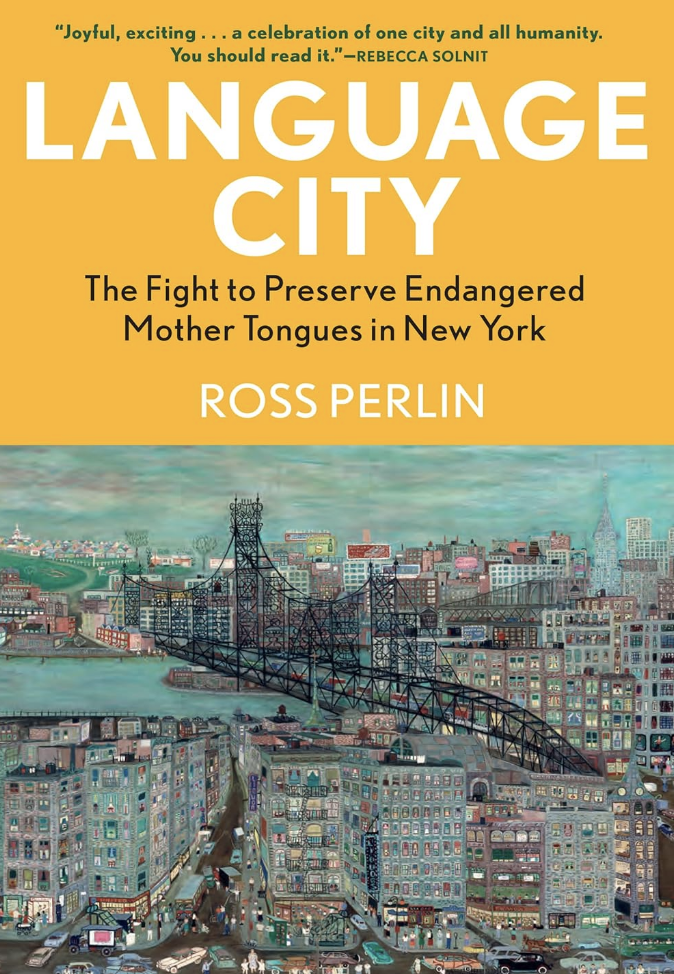Ross Perlin, a native New Yorker, is a lexicographer and the author of a perceptive book about the ‘little indignities and pointless errands’ inflicted on interns. He’s also an expert on Himalayan languages and a champion of multilingualism, who co-directs the Endangered Language Alliance, a non-profit which supports linguistic diversity. On the streets near his home in Queens, he hears Polish, Ukrainian, Egyptian Arabic and multiple variants of Spanish. Venturing further afield in the borough he finds tight communities of Uzbeks, Filipinos, Bangladeshis and Guyanese. A car’s licence plate broadcasts its owner’s Puerto Rican roots. A bumper sticker reads, in English, ‘I am proud to be a Coptic.’
Elsewhere in Queens, Perlin meets people who describe themselves as Romanian Serbians and Albanian Montenegrins. He drops in on the Gottscheers, whose community hall is the last outpost of a Germanic language that developed 700 years ago in a forested enclave in Slovenia. Nearby he encounters Nones, a dialect of the Ladin language that originates in Trentino, while in the park retired Gurkha soldiers shoot hoops, calling for the ball in Nepali, their lingua franca. Always on the lookout for evidence of linguistic plurality, he’s stirred by local efforts to bolster Breton, by meeting a young boy who seems to wish his parents would pass on their knowledge of Garifuna, and by a tale of a Kosovar-Polish romance, beset by communication problems, in neighbouring Brooklyn.
Today’s New York is home to more than 700 languages. Plenty thrive, but some are in jeopardy. This ardently revelatory book portrays the city, the ‘most linguistically diverse … in the history of the world’, as the ‘last improbable refuge’ for speakers of certain tongues that face extinction. Where others might see language death as inevitable and inexorable, Perlin rages against the dying of the light. His aim is not to downplay the importance in New York of knowing English, or the value of the city’s other prominent languages — chief among which is Spanish, followed at some remove by Chinese, Italian, Russian and Korean. Yet because global turbulence means that many speakers of embattled languages are currently on the move, they are now not ‘confined to remote islands, towering mountains, or impenetrable jungles’, but ‘right next door, though to majority groups they remain invisible and their words inaudible’.
Perlin wants to amplify such voices, and to this end follows six New Yorkers who are striving to preserve or revitalize their languages. Among his ports of call is an apartment building in Flatbush which has been home to over 100 of the world’s 700 speakers of Seke, a Sino-Tibetan language used in the north of Nepal. His contact there is Rasmina, a nurse who learned it from her grandmother. Together, over five years, they assemble a dictionary of Seke. An ‘evidential’ language, it has different grammatical forms to mark whether an assertion is grounded in observation or inference, hearsay or a hunch. One day he and Rasmina puzzle over the verb pungba, which in its compound forms can mean ‘sing’, ‘conspire’ or ‘stab’; another, they discuss the best English rendering of a Seke term for a ritual which literally translates as ‘demon throwing’.
A few blocks south in Midwood is Husniya, a software engineer. English is her ninth language. She has ambitions to write children’s literature in Wakhi, a language spoken in the high mountains where Tajikistan, Pakistan, Afghanistan and China converge. Wakhi is richly endowed, explains Perlin, with ‘far-back-in-the-mouth sounds’, and lends itself to a narrative style with a ‘trance-like pattern of rhythm’. Books for children in Wakhi, or in any of its kindred Pamiri languages, are scarce, and Husniya hopes not only to make a symbolic statement, but to provide valuable tools for parents.
When Perlin visits the rugged valleys of Tajikistan with Husniya, he admires both her deep social networks and her gumption. She even considers risking a brush with the Taliban to cross into Afghanistan so that they can record people speaking under-documented languages such as Munji, Yidgha and Sanglechi. In the quieter moments on their journey, Perlin proves as attuned to endangered foodways as to languages in peril, pausing to make notes about dishes such as a dried apricot soup. He’s no less intrigued by the unfamiliar musical instruments, among them a six-stringed fretless long-necked lute called a rubob and a ‘spike fiddle’ known as a ghizhak. [continues…]
